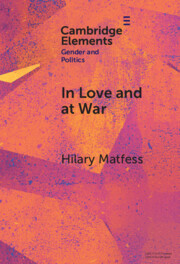Element contents
In Love and at War
Published online by Cambridge University Press: 26 January 2024
Summary
- Type
- Element
- Information
- Series: Elements in Gender and PoliticsOnline ISBN: 9781009358859Publisher: Cambridge University PressPrint publication: 15 February 2024
References
- 10
- Cited by

